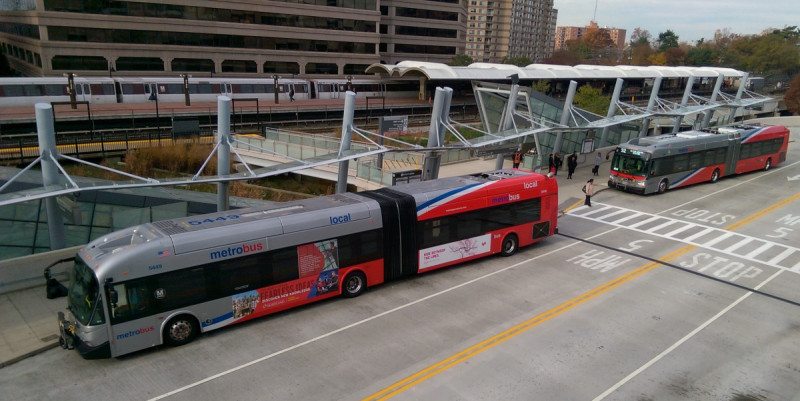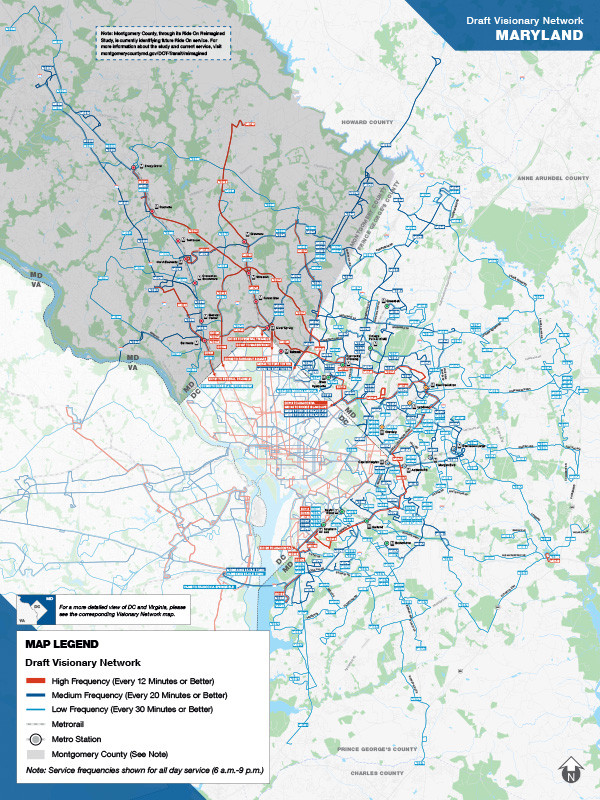What Better Bus means for riders in Maryland and Virginia

Metrobuses at Paul Sarbanes Transit Center in Silver Spring. Image by WMATA.
The Metrobus network we have today is in large part a mashup of routes that previous transit companies ran decades ago with smaller, more incremental tweaks made since then. Local bus systems, like The Bus in Prince George’s County or Fairfax Connector in Fairfax County, have filled in the gaps. Still, many Metrobus routes reflect outdated travel patterns, or don’t go to places that are now major destinations because they were farm fields 50 years ago.
Enter Better Bus, WMATA’s proposal for a redesigned and radically expanded Metrobus network, with more service to more places at more times of the day and week. Throughout the spring, Metro has hosted dozens of events across DC, Maryland, and Virginia to promote Better Bus and collect input from riders and residents. Let’s take a closer look at the proposed Visionary Network and, in particular, what it means for riders in Maryland and Virginia.
Draft visionary network for Maryland. Map by WMATA. 
Dan: *swept away with the romance of an expanded bus network*
WMATA is working with most of the suburban bus systems to holistically redesign the entire system. (Montgomery County’s Ride On isn’t participating while it does its own redesign, though Metro’s process still recommends changes for its own routes in the county.) Since the start of Covid, bus ridership in the DC area has rebounded faster than Metrorail, especially in the suburbs. With that in mind, the Visionary Network recommends significantly more service in Maryland and Virginia.
There would be twice as many frequent routes (20 minutes or better) in Virginia, and five times as many in Maryland, along with dramatically expanded midday, evening, and weekend service. As a result, WMATA anticipates that the proposed network could add 22,000 more weekday trips and 17,000 more weekend trips in Maryland and Virginia. While there are too many changes to cover in a single blog post, here are a few big themes for Better Bus in Maryland and Virginia:
Buses will go to more outlying areas. Columbia is the largest census-designated place (aka an unincorporated town) in Maryland, with over 100,000 residents. Despite being physically closer to DC than Ashburn, the last stop on the Silver Line, the only transit service to DC are commuter buses that run during rush hour. For the first time, Better Bus recommends extending all-day bus service to the Howard County community, along with the other two largest communities in Maryland, Germantown in Montgomery County and Waldorf in Charles County (Waldorf WMATAwide?), as well as Upper Marlboro, the Prince George’s County seat of government.
More late-night bus service. Old heads will remember that Metro used to run until 3am on the weekends! While it’s unlikely that this will come back, Better Bus recommends substantially expanding 24-hour bus service. Some of these routes follow the Metro lines as a replacement for train service. Others travel further out, to places where people are likely to be out working or partying late (National Harbor in Prince George’s County) or places that already have some late-night service (the Z buses along Route 29 in Montgomery County, which run until 2am). The result: 371,000 people in Maryland, and 306,000 in Northern Virginia will now have access to 24-hour bus service.
Way more express service. Today, there are a number of express bus routes on highways in Maryland and Virginia, most of which only run during rush hour and carry riders from suburban park-and-rides to either Metro stations or downtown DC. The Visionary Network builds on that with more all-day express routes, and more routes between major suburban destinations. Metro previously tried that in the 1990s with an express bus over the American Legion Bridge between Lakeforest Mall in Maryland and Tysons Corner in Virginia, but it was cancelled due to low ridership.
The Visionary Network brings that back, with a Bethesda-Tysons line crossing the Legion Bridge, as well as new service over the Woodrow Wilson Bridge between Old Town Alexandria and Franconia-Springfield in Virginia and Suitland and National Harbor in Maryland. In Montgomery County, a new express line along the Intercounty Connector highway would run between Germantown and Silver Spring.
New suburban Metrobus hubs. Today, WMATA and the local bus systems operate several suburban “Transit Centers,” like Shirlington in Arlington County or Takoma-Langley in Prince George’s County, but the biggest ones tend to be pretty close-in. The Visionary Network envisions a new White Oak Medical Center hub in Montgomery County, home to the Food and Drug Administration and the new Washington Adventist Hospital, as well as Inova Alexandria Hospital and George Mason University in Virginia.
More cross-county routes. Maryland and Virginia have several long bus routes that follow a single street–think the Y buses on Georgia Avenue in Montgomery County, or the 29 buses on Little River Turnpike in Fairfax County–that have existed for decades. They’re the workhorse buses of the suburbs, with high ridership all day, every day. But they’re also focused on taking people into and out of DC, which can make trips within the county difficult.
The Visionary Network introduces several frequent bus routes that, like the Purple Line, connect big suburban destinations to one another. In Montgomery County, that includes a route between Olney, Wheaton, and downtown Bethesda, one of the region’s largest job centers. And in Prince George’s, there’s a new inside-the-Beltway route between New Carrollton, Addison Road, Suitland, and Southern Avenue, connecting all four of the Metro lines that serve the county. Both of these routes are proposed to come every 12 minutes or less throughout the day.
Draft visionary network for Virgina. Map by WMATA. 
Check out the map, share your thoughts
We love a vastly expanded bus network, but without a significant increase in funding, the Visionary Network likely won’t happen. Thus, Metro has to figure out which parts of this network are the biggest priority for riders, which will guide their final recommendations. That’s where you come in. Metro is particularly interested in specific comments about the proposed routes, or where routes can be improved.
Here are some ways you can give feedback, by June 18th (the deadline was moved back to allow for more people to comment):
- Visit wmata.com/betterbus
- Take a look at the map. You can select a current bus route from the dropdown menu to see relevant new routes in the proposed Visionary Network.
- Click “Add Comment” and click anywhere on the map to tell us what you like, need, or don’t like.
(Editor’s note: This article has been edited to reflect that Howard County is recommended to provide expanded bus service, not specifically Metrobus service.)
